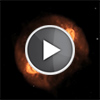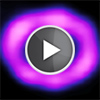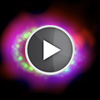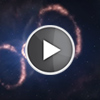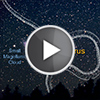CXC Home | Search | Help | Image Use Policy | Latest Images | Privacy | Accessibility | Glossary | Q&A
3D Visualization of SN 1987A
Quicktime MPEG
This video shows a visualization of SN 1987A and the evolution of the resulting supernova remnant up until the present day. The visualization begins by showing the progenitor star surrounded by a ring of gas produced late in the life of the star. A flash of light depicts the supernova explosion, followed by expansion of the subsequent blast wave. The blast wave then collides with the ring of gas, causing high-density knots of material to become hotter and brighter, and lower-density gas to be blown outward. One frame is shown per year and the visualization steps between them at four years per second. Upon reaching the present day (February 2017), the time development is halted, and the camera circles around the ring to show its structure.
This visualization is based on a sophisticated 3D simulation published by Salvatore Orlando that incorporates the physics of SN 1987A, including the complex interaction between radiation and matter and relativistic effects. The simulation reproduces the observed properties of the supernova, including how the radiation, temperature and velocity of the debris vary with time. The simulation then reproduces the properties of the subsequent supernova remnant, including how the shape of the X-ray structure, as well as the amount of X-rays observed at different wavelengths, evolve with time.
[Runtime: 00:22]
Quicktime MPEG
This video shows a visualization of SN 1987A and the evolution of the resulting supernova remnant up until the present day. The visualization begins by showing the progenitor star surrounded by a ring of gas produced late in the life of the star. A flash of light depicts the supernova explosion, followed by expansion of the subsequent blast wave. The blast wave then collides with the ring of gas, causing high-density knots of material to become hotter and brighter, and lower-density gas to be blown outward. One frame is shown per year and the visualization steps between them at four years per second. Upon reaching the present day (February 2017), the time development is halted, and the camera circles around the ring to show its structure.
This visualization is based on a sophisticated 3D simulation published by Salvatore Orlando that incorporates the physics of SN 1987A, including the complex interaction between radiation and matter and relativistic effects. The simulation reproduces the observed properties of the supernova, including how the radiation, temperature and velocity of the debris vary with time. The simulation then reproduces the properties of the subsequent supernova remnant, including how the shape of the X-ray structure, as well as the amount of X-rays observed at different wavelengths, evolve with time.
[Runtime: 00:22]
(Simulation Credit: Salvatore Orlando (INAF-Osservatorio Astronomico di Palermo)
Visualization Credit: NASA, ESA, and F. Summers and G. Bacon (STScI))
Chandra X-ray Time-lapse movie of SN 1987A
Quicktime MPEG
From 1999 until 2013, Chandra data showed an expanding ring of X-ray emission that had been steadily getting brighter. This was produced by the blast wave from the original explosion that had been bursting through and heating the ring of gas surrounding the supernova. In the past few years, there have been striking changes in the Chandra data. This provides evidence that the explosion's blast wave has moved beyond the ring into a region with less dense gas. This represents the end of an era for SN 1987A. Since astronomers do not know exactly lies beyond the ring, they will be watching carefully what happens next.
Still images (frames) from this animation.
[Runtime: 00:22]
Quicktime MPEG
From 1999 until 2013, Chandra data showed an expanding ring of X-ray emission that had been steadily getting brighter. This was produced by the blast wave from the original explosion that had been bursting through and heating the ring of gas surrounding the supernova. In the past few years, there have been striking changes in the Chandra data. This provides evidence that the explosion's blast wave has moved beyond the ring into a region with less dense gas. This represents the end of an era for SN 1987A. Since astronomers do not know exactly lies beyond the ring, they will be watching carefully what happens next.
Still images (frames) from this animation.
[Runtime: 00:22]
(Simulation Credit: Salvatore Orlando (INAF-Osservatorio Astronomico di Palermo)
Visualization Credit: NASA, ESA, and F. Summers and G. Bacon (STScI))
A Tour of Supernova 1987A
Quicktime MPEG With closed-captions (at YouTube)
Thirty years ago on February 24, 1987, observers in the southern hemisphere noticed a new object in the Large Magellanic Cloud. Today, we know this object as Supernova 1987A, and it was one of the brightest supernova seen in hundreds of years. Coupled with its relative proximity at about 160,000 light years from Earth, Supernova 1987A became one of the best opportunities ever for astronomers to study the phases before, during, and after the death of a star.
Since its discovery, telescopes around the world and in space have observed Supernova 1987A. This includes NASA's Chandra X-ray Observatory, which has looked at this object repeatedly during its 17 years of science operations.
From 1999 until 2013, Chandra data showed an expanding ring of X-ray emission that had been steadily getting brighter. This was produced by the blast wave from the original explosion that had been bursting through and heating the ring of gas surrounding the supernova.
In the past few years, there have been striking changes in the Chandra data. This provides evidence that the explosion's blast wave has moved beyond the ring into a region with less dense gas. This represents the end of an era for SN 1987A. Since astronomers do not know exactly lies beyond the ring, they will be watching carefully what happens next.
Over the next few thousand years, the expanding shell of hot gas will continue to glow in X rays. Eventually after rumbling across several thousand light years, the shell will disperse. By doing this, the supernova spreads the heavy elements created in the star and possibly triggers the formation of new stars from a cold interstellar cloud. Using data from Chandra and other telescopes, astronomers will continue to learn more about the details of this very important process that is responsible for life as we know it.
[Runtime: 03:09]
Quicktime MPEG With closed-captions (at YouTube)
Thirty years ago on February 24, 1987, observers in the southern hemisphere noticed a new object in the Large Magellanic Cloud. Today, we know this object as Supernova 1987A, and it was one of the brightest supernova seen in hundreds of years. Coupled with its relative proximity at about 160,000 light years from Earth, Supernova 1987A became one of the best opportunities ever for astronomers to study the phases before, during, and after the death of a star.
Since its discovery, telescopes around the world and in space have observed Supernova 1987A. This includes NASA's Chandra X-ray Observatory, which has looked at this object repeatedly during its 17 years of science operations.
From 1999 until 2013, Chandra data showed an expanding ring of X-ray emission that had been steadily getting brighter. This was produced by the blast wave from the original explosion that had been bursting through and heating the ring of gas surrounding the supernova.
In the past few years, there have been striking changes in the Chandra data. This provides evidence that the explosion's blast wave has moved beyond the ring into a region with less dense gas. This represents the end of an era for SN 1987A. Since astronomers do not know exactly lies beyond the ring, they will be watching carefully what happens next.
Over the next few thousand years, the expanding shell of hot gas will continue to glow in X rays. Eventually after rumbling across several thousand light years, the shell will disperse. By doing this, the supernova spreads the heavy elements created in the star and possibly triggers the formation of new stars from a cold interstellar cloud. Using data from Chandra and other telescopes, astronomers will continue to learn more about the details of this very important process that is responsible for life as we know it.
[Runtime: 03:09]
(Credit: X-ray: NASA/CXC/SAO/PSU/K.Frank et al.; Optical: NASA/STScI; Millimeter: ESO/NAOJ/NRAO/ALMA)
The material around SN 1987A (artist's impression)
Quicktime MPEG
This artist's impression of the material around a recently exploded star, known as Supernova 1987A (or SN 1987A), is based on observations which have for the first time revealed a three dimensional view of the distribution of the expelled material. The observations were made by astronomers using ESO's Very Large Telescope. The original blast was not only powerful, according to the new results. It was also more concentrated in one particular direction. This is a strong indication that the supernova must have been very turbulent, supporting the most recent computer models. This video shows the different elements present in SN 1987A: two outer rings, one inner ring and the deformed, innermost expelled material.
Just how a supernova explodes is not very well understood, but the way the star exploded is imprinted on this inner material. The astronomers could deduce that this material was not ejected symmetrically in all directions, but rather seems to have had a preferred direction. Besides, this direction is different to what was expected from the position of the rings.
[Runtime: 00:31]
Quicktime MPEG
This artist's impression of the material around a recently exploded star, known as Supernova 1987A (or SN 1987A), is based on observations which have for the first time revealed a three dimensional view of the distribution of the expelled material. The observations were made by astronomers using ESO's Very Large Telescope. The original blast was not only powerful, according to the new results. It was also more concentrated in one particular direction. This is a strong indication that the supernova must have been very turbulent, supporting the most recent computer models. This video shows the different elements present in SN 1987A: two outer rings, one inner ring and the deformed, innermost expelled material.
Just how a supernova explodes is not very well understood, but the way the star exploded is imprinted on this inner material. The astronomers could deduce that this material was not ejected symmetrically in all directions, but rather seems to have had a preferred direction. Besides, this direction is different to what was expected from the position of the rings.
[Runtime: 00:31]
(Credit: ESO/L. Calçada)
A Zoom into Supernova 1987A
Quicktime MPEG
The video begins with a nighttime view of the Small and Large Magellanic clouds, satellite galaxies of our Milky Way. It then zooms into a rich star-birth region in the Large Magellanic Cloud. Nestled between mountains of red-colored gas is the odd-looking structure of Supernova 1987A, the remnant of an exploded star that was first observed in February 1987. The site of the supernova is surrounded by a ring of material that is illuminated by a wave of energy from the outburst. Two faint outer rings are also visible. All three rings existed before the explosion as fossil relics of the doomed star's activity in its final days.
[Runtime: 00:33]
Quicktime MPEG
The video begins with a nighttime view of the Small and Large Magellanic clouds, satellite galaxies of our Milky Way. It then zooms into a rich star-birth region in the Large Magellanic Cloud. Nestled between mountains of red-colored gas is the odd-looking structure of Supernova 1987A, the remnant of an exploded star that was first observed in February 1987. The site of the supernova is surrounded by a ring of material that is illuminated by a wave of energy from the outburst. Two faint outer rings are also visible. All three rings existed before the explosion as fossil relics of the doomed star's activity in its final days.
[Runtime: 00:33]
(Credit: NASA, ESA, and G. Bacon (STScI))
Return to Supernova 1987A (February 24, 2017)


